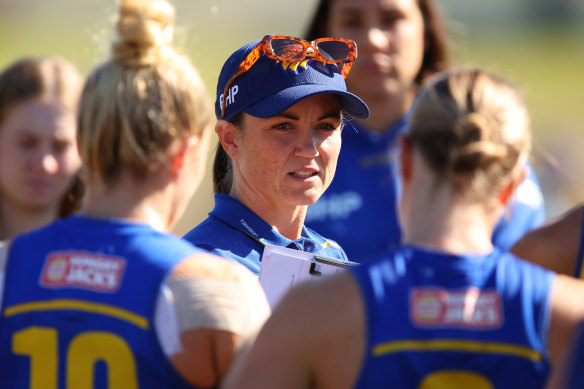This was published 5 months ago
Opinion
Bring it on! Why I can’t wait for AFLW pre-season training to start
Libby Birch
AFL columnistW is back!
This season brings significant changes to the AFLW competition. Here are the things you need to know.
Players return for the official start of pre-season training on Monday. Depending on whether they played finals or not, the players have had between six and seven months off. While this might seem a long time away from the game, it provides a crucial window for rest, recovery, and preparation. It’s a huge opportunity to rebuild, recharge, and come back stronger.

The West Coast Eagles kickstarting their pre-season campaign under new coach Daisy Pearce.Credit: Getty Images
So, what do players get up to? Some players focus on work, others travel, but all are engaged in preparation well before the official pre-season begins. This phase, often referred to as “pre-pre-season,” involves significant physical conditioning and skill development.
This year AFLW players are now on 12-month contracts; a new arrangement that acknowledges the continuous effort required to maintain peak fitness and strength throughout the off-season. For a player who has changed clubs in the off-season – like me after my move from Melbourne to North Melbourne – the off-season has been a chance to connect with new teammates.
Balancing the right time to resume training is a critical decision for all players and clubs. With the advent of full-time high-performance managers at most clubs, training loads are now meticulously planned throughout the year to ensure players peak by round one, usually near the time of the AFL’s pre-finals bye.
Off-season programming typically includes participation in respective state leagues. However, opinions on the benefits of these competitions vary.
As it stands, no state runs a second-tier women’s competition alongside the AFLW season. Subsequently, teams have the luxury of designing their off-season programs based on their team and specific needs. This might involve integrating new players, providing players with game time, particularly those who had limited minutes due to form or injury in the previous season, or focusing on skills and physical fitness.

Emma Moore has taken on the role of running the AFLW.Credit: Simon Schluter
Hawthorn champion Emily Bates, who was the season-six AFLW best-and-fairest winner, played the opening two rounds of the VFLW season for the Box Hill Hawks, so too recruits Eliza West and Casey Sherriff. New coach Daniel Webster joined the Hawks in February, and has made it clear that he wanted his group adapting to their new game style.
I’m excited to see what my good friend and former teammate Daisy Pearce can accomplish as the new coach of the West Coast Eagles. Likewise, I know Tam Hyett, my old back-line coach at Melbourne, has been working diligently in her new role as head coach of the Bulldogs. Meanwhile, Sam Wright has undoubtedly been preparing his fresh strategy for the 2024 season with the Magpies.
With so many changes in the coaching ranks, we’re bound to see significant game plan shake-ups and a faster, more skilful game overall.
Building on the improvement witnessed in the AFLW in 2023, Victoria’s second-tier comp, the VFLW, has taken great strides in season 2024. Scoring has increased by 45 per cent, driven by the return of more AFLW players to the competition. Ball-tracking technology has also been trialled, with a view to it being implemented at the higher grade in the near future.
Sydney and Greater Western Sydney joined the VFLW this year for a five-game invitational, marking their first inclusion since 2019, while clubs also held scratch matches against each other. These games were a valuable way for teams, particularly West Coast, Fremantle and Gold Coast to get some extra work in before the official pre-season begins.
It was also a great way for these clubs to bring their men’s and women’s teams together – when the Eagles’ men’s side played Gold Coast one Sunday, their AFLW team joined them on a chartered flight to Queensland for their respective clash with the Suns.
For the first time, the league also held a joint AFL and AFLW general managers’ forum to discuss competitive balance and state-based issues, a significant step towards greater integration and collaboration between the leagues. Following the departure of Nicole Livingstone after seven years at the helm of the AFLW, Emma Moore has become the league’s general manager. Her leadership will bring fresh perspectives and continued growth for the league.
The 2024 fixture also contains the introduction of an AFLW Dreamtime game in Darwin, featuring Richmond and Essendon to celebrate Indigenous culture.
The season will comprise 11 rounds played over 10 weeks, with games on Tuesday and Wednesday nights. It is aimed at gauging interest and making the game more accessible, particularly during the September school holidays, offering families the chance to attend matches at family-friendly times and venues.
I’m sure I speak for every player when I say we can’t wait for the official start this week, marked by customary time trials and tests. Suddenly, everything gets a bit more serious as the clock starts ticking down and tensions rise.
Although last year’s champions, the Brisbane Lions, will clearly start 2024 as the favourites, I’m eager to see how hungry all the challengers are over the next few months, both on and off the track.
Keep up to date with the best AFL coverage in the country. Sign up for the Real Footy newsletter.